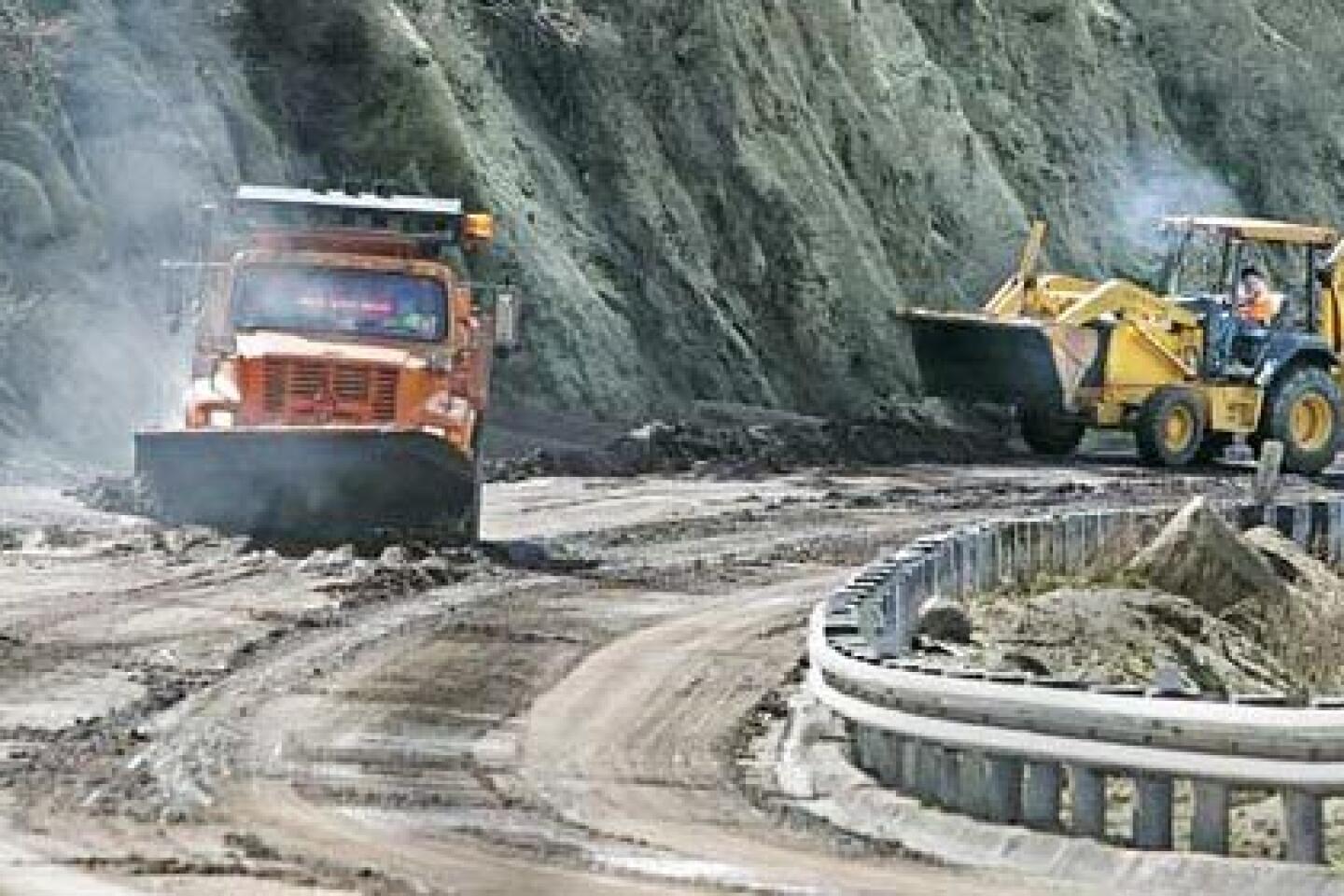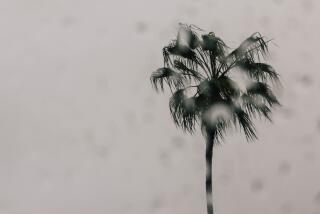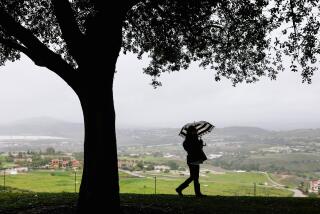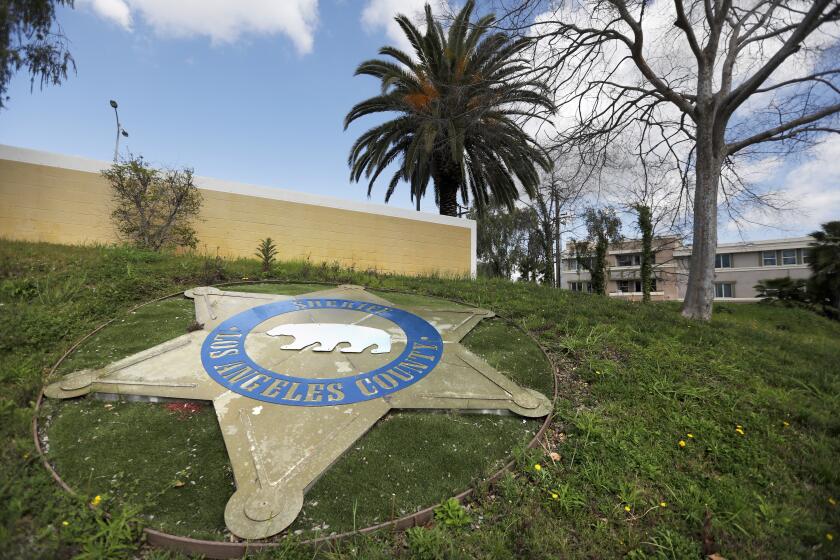Wet, but not wild -- so far
Scientists warned evacuation-weary residents of Southern California’s burn areas on Sunday not to become complacent about potentially deadly mudslide conditions, even as the season’s heaviest rainstorm yet appeared to be easing without causing major damage.
After seven wet days, capped by 2 to 4 inches of rainfall Saturday and Sunday in many areas, researchers said charred hillsides in Los Angeles and Orange counties have become dangerously soggy and prone to sliding.
“We’ve been dancing on the edge of a big event for the last month, really,” said Kevin Schmidt, a U.S. government geologist who spent Sunday monitoring soil sensors that measure saturation in the burn areas. “I’m going to keep my fingers crossed that we make it through the night.”
Sue Cannon, another geologist with the U.S. Geological Survey’s landslide hazards program, said the back-to-back storms were not allowing the ground to dry sufficiently. “The risk is still really there, and right there. . . . It still is a very hazardous situation.”
Less intense, on-and-off showers predicted for the next several days could provide some relief, officials said. But they also stressed that identifying the triggers for landslides and debris flows was an inexact science. And they said they had seen troubling signs during the weekend storms.
Soil sensors above Malibu showed porous spaces in the ground were filled with twice the normal amount of water during the intense rains Saturday, Schmidt said. That triggered minor floods and debris flows in uninhabited canyon areas. If heavy rains hit those areas in the coming weeks or months, he said, overland floods and destructive mudflows “several feet high and several feet wide” could stream down “faster than a person can run.”
Experts also spotted gullies forming and concentrating runoff on high hillsides. Known as “rilling,” these flows can cut deeply as they course down canyons and gather soil, gravel and sand, increasing the threat of land and rock slides, said Jim Bowers, a federal hydrologist based in San Bernardino.
Even a moderate mud and debris flow from a steep, denuded hillside can kill or injure those trapped below, Cannon said. “If it’s carrying boulders the size of your head, it can break your leg or bash through your wall.” Heavier debris flows can wash away cars or houses, she said.
In badly burned Modjeska Canyon in Orange County, fewer and fewer residents have heeded the successive evacuation warnings because they are tiring of uprooting their families and pets. Some suspect authorities are overstating the danger.
“Look, I’m sure that they have the people’s welfare in their mind and in their heart, and that’s good,” said Jim Sill, who has lived at the canyon’s back edge for 24 years. But he said the repeated evacuation orders, without large slides or debris flows occurring, was hurting Orange County officials’ credibility.
“Unless something really dire happens one of these times, nobody is going to believe them,” he said.
The close succession of storms was also taking a toll on those whose job is to keep tabs on them. “Oh my word. Come on, give us a break!” said Cannon, when she heard of the severe thunderstorm warning issued for Southern and Central California, extending to this morning.
The weekend storms brought the heaviest rainfall of the winter season, dumping more than 4 inches on some parts of Southern California in 24 hours. Nearly 2 inches had fallen in downtown Los Angeles, topping the 1.5 inches reported Jan. 4, the season’s previous heaviest 24-hour total. More than 5 inches was recorded in downtown over the last week.
Valley and mountain areas had the most rain, with about 7.5 inches falling over the last week in Sepulveda Pass area.
Temperatures dipped sharply in Southern California mountains, and 10 to 20 inches of new snow were forecast for higher elevations Sunday and early today. Avalanches last week near Wrightwood claimed three lives.
Skiers and snowboarders flocked to resorts Sunday. Officials at Mountain High in Wrightwood said at least 4 feet of snow fell there over the weekend, and at Snow Summit near Big Bear, officials said snow was still late falling late Sunday on a base of 2 to 3 feet.
Authorities said the weather may have been a factor in at least two traffic accidents, including one fatality Sunday morning.
A 45-year-old man driving near the intersection of Hubbard Street and Gavina Avenue lost control of his vehicle, causing it to spin out of control and land in the Pacoima Wash flood control channel, said Los Angeles Police Department spokeswoman Norma Eisenman. The man, who was not immediately identified, was pronounced dead at the scene shortly after 7:25 a.m.
Eisenman said she was “sure it had to do with the wet roads.”
In another incident shortly before 8 a.m., a vehicle skidded off the Pasadena Freeway near Avenue 43, landing in several inches of water 30 feet below the roadway. The car landed upright, said Los Angeles City Fire spokesman Ron Myers, and two occupants, who suffered fractures and other injuries, were rescued by firefighters.
Worried that the Big Tujunga Dam would overflow, county engineers opened the floodgates at the facility in the San Gabriel Mountains, releasing 500 cubic feet of water per second.
Department of Public Works spokesman Gary Bozé said the controlled flooding was “normal protocol” during heavy storms.
The storm’s effects were felt inside Staples Center, where the Lakers were playing the Cleveland Cavaliers.
The game was delayed 12 minutes when water began dripping from high inside the arena, hitting the court near the basket closest to the Lakers’ bench. At first, it appeared to be a leaky ceiling. But a center official said workers who had been outside peeled off wet clothes and slung them over a catwalk.
“We had a roofing company on the roof this morning, inspecting it,” said Staples Center spokesman Michael Roth. “When they got done with their inspections up there, they came down though a catwalk system, took their rain gear off and left it there. . . . It was their wet clothing on the catwalk dripping through the grates.”
As of Sunday, more than 10 inches of rain had fallen this season in downtown Los Angeles, about 4 inches more than normal, Seto said. The wet weather is expected to continue into today, with the chance of showers diminishing this afternoon.
Smaller storms are expected later in the week.
Times staff writer Rich Connell contributed to this report.
More to Read
Start your day right
Sign up for Essential California for news, features and recommendations from the L.A. Times and beyond in your inbox six days a week.
You may occasionally receive promotional content from the Los Angeles Times.












